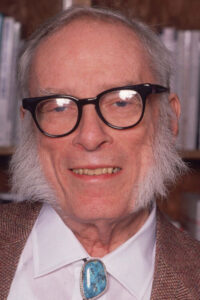
Youth
“Slim!”
The call was a hoarse, urgent whisper, and the youngster bounded to the open window.
Slim wasn’t his real name, but the new friend he had met the day before had needed only one look at his slight figure to say, “You’re Slim.” He added, “I’m Red.”
Red wasn’t his real name, either, but its appropriateness was obvious. They were friends instantly with the quick unquestioning friendship of young ones not yet quite in adolescence, before even the first stains of adulthood began to make their appearance.
Slim cried, “Hi, Red!” and waved cheerfully, still blinking the sleep out of himself.
Red kept to his croaking whisper, “Quiet! You want to wake somebody?”
Slim noticed all at once that the sun scarcely topped the low hills in the east, that the shadows were long and soft, and that the grass was wet.
Slim said, more softly, “What’s the matter?”
Red only waved for him to come out.
Slim dressed quickly, gladly confining his morning wash to the momentary sprinkle of a little lukewarm water. He let the air dry the exposed portions of his body as he ran out, while bare skin grew wet against the dewy grass.
Red said, “You’ve got to be quiet. If Mom wakes up or Dad or your Dad or even any of the hands then it’ll be ‘Come on in or you’ll catch your death of cold.'”
He mimicked voice and tone faithfully so that Slim laughed and thought that there had never been so funny a fellow as Red.
Read or download Book
Isaac Asimov
Isaac Asimov (born January 2, 1920, in Petrovichi, Russia—died April 6, 1992, New York, New York, U.S.) was an American author and biochemist, a highly successful and prolific writer of science fiction and science books for the layperson.
Biography.
He wrote or edited about 500 volumes, of which the most famous are those in the Foundation and Robot series.
Asimov was brought to the United States at age three. He grew up in Brooklyn, New York, and graduated from Columbia University in 1939. During World War II, he worked at the Naval Aviation Experimental Station in Philadelphia along with science-fiction authors Robert Heinlein and L. Sprague de Camp. After the war, he took a Ph.D. in chemistry from Columbia in 1948. He then joined the faculty of Boston University, with which he remained associated thereafter.
Asimov began contributing stories to science-fiction magazines in 1939. He sold his first story, “Marooned off Vesta” to Amazing Stories, but he was most closely associated with Astounding Science-Fiction and its editor, John W. Campbell, Jr., who became a mentor to Asimov. “Nightfall” (1941), about a planet in a multiple-star system that only experiences darkness for one night every 2,049 years, brought him to the front rank of science-fiction writers and is regarded as one of the genre’s greatest short stories.
In 1940 Asimov began writing his robot stories (later collected in I, Robot [1950]). In the 21st century, “positronic” robots operate according to the Three Laws of Robotics:
- A robot may not injure a human being, or, through inaction, allow a human being to come to harm;
- A robot must obey the orders given to it by human beings except where such orders would conflict with the First Law;
- A robot must protect its existence as long as such protection does not conflict with the First or Second Laws.
By developing (with Campbell) a set of ethics for robots and rejecting previous conceptions of them as marauding metal monsters, Asimov greatly influenced other writers’ treatment of the subject.
“The Encyclopedists” (1942) was the beginning of Asimov’s popular Foundation series. Loosely modeled on the fall of the Roman Empire, the Foundation series begins in the last days of the Galactic Empire. Hari Seldon devises a discipline, “psychohistory,” that allows the prediction of future historical currents. He sets into motion a plan to reduce the predicted 30,000-year galactic dark ages to 1,000 years by gathering the brightest minds on the planet Terminus to form the Foundation of a new Galactic Empire. Seldon also establishes a mysterious Second Foundation in an unknown location. The Foundation struggles to keep civilization alive, while, at moments of acute crisis predicted by psychohistory, recordings of the long-dead Seldon dispense advice. The stories, written between 1942 and 1949, were collected as the Foundation trilogy: Foundation (1951), Foundation and Empire (1952), and Second Foundation (1953). The trilogy won a special Hugo Award in 1966 for best science-fiction series of all time.






